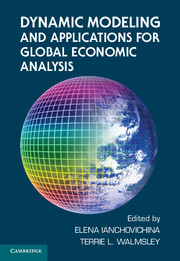Book contents
- Frontmatter
- Contents
- Contributors
- Acknowledgments
- PART I INTRODUCTION AND OVERVIEW
- PART II STRUCTURE OF THE DYNAMIC GTAP FRAMEWORK
- 2 Theoretical Structure of Dynamic GTAP
- 3 Behavioral and Entropy Parameters in the Dynamic GTAP Model
- 4 An Overview of the Dynamic GTAP Data Base: The Data Base Construction and Aggregation Programs
- 5 A Baseline Scenario for the Dynamic GTAP Model
- 6 Welfare Analysis in the Dynamic GTAP Model
- 7 Implementing the Dynamic GTAP Model in the RunDynam Software
- PART III APPLICATIONS OF DYNAMIC GTAP
- PART IV EVALUATION OF THE DYNAMIC GTAP FRAMEWORK
- Appendix: Negative Investment: Incorporating a Complementarity into the Dynamic GTAP Model
- Glossary of GDyn Notation
- Index
- References
7 - Implementing the Dynamic GTAP Model in the RunDynam Software
Published online by Cambridge University Press: 05 June 2012
- Frontmatter
- Contents
- Contributors
- Acknowledgments
- PART I INTRODUCTION AND OVERVIEW
- PART II STRUCTURE OF THE DYNAMIC GTAP FRAMEWORK
- 2 Theoretical Structure of Dynamic GTAP
- 3 Behavioral and Entropy Parameters in the Dynamic GTAP Model
- 4 An Overview of the Dynamic GTAP Data Base: The Data Base Construction and Aggregation Programs
- 5 A Baseline Scenario for the Dynamic GTAP Model
- 6 Welfare Analysis in the Dynamic GTAP Model
- 7 Implementing the Dynamic GTAP Model in the RunDynam Software
- PART III APPLICATIONS OF DYNAMIC GTAP
- PART IV EVALUATION OF THE DYNAMIC GTAP FRAMEWORK
- Appendix: Negative Investment: Incorporating a Complementarity into the Dynamic GTAP Model
- Glossary of GDyn Notation
- Index
- References
Summary
Introduction
The purpose of this chapter is to introduce the reader to the publicly available software – RunDynam – that is used to carry out the applications presented in Part III of this book. The RunDynam program is based on the GEMPACK suite of software (Harrison and Pearson 1998),which is specifically designed to solve nonlinear general equilibrium models. Other general equilibrium models solved using the GEMPACK software suite include the standard GTAP model and the Monash model of Australia. The RunDynam program has been specially tailored to the needs of the GDyn model and other dynamic models. It offers the user a great deal of flexibility in constructing simulations. It is available from the Centre of Policy Studies at Monash University, Australia.
Using the RunDynam software, you can examine the data, construct and modify simulations, solve simulations, and examine results. Users who wish to alter the underlying theory of the model will need to acquire additional software from the Centre of Policy Studies at Monash University, Australia. In addition, those who wish to make their own aggregations will have to purchase the GTAP Data Base from the Center for Global Trade Analysis, Purdue University. Altering the standard model and the data aggregation process are not discussed in this chapter.
- Type
- Chapter
- Information
- Dynamic Modeling and Applications for Global Economic Analysis , pp. 173 - 202Publisher: Cambridge University PressPrint publication year: 2012

